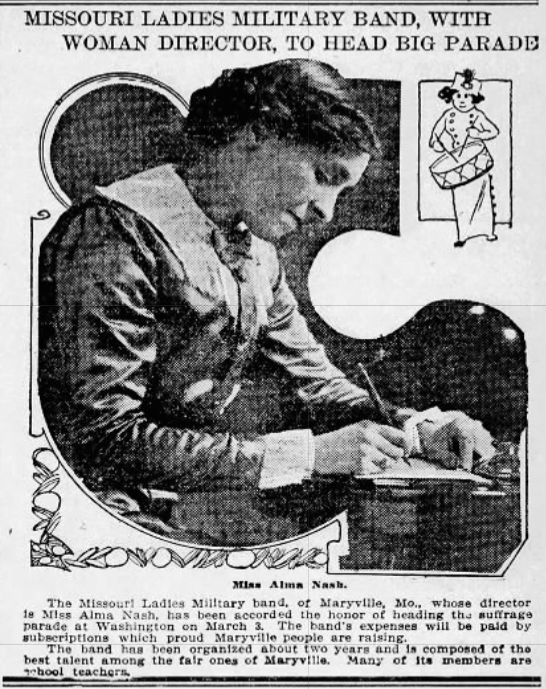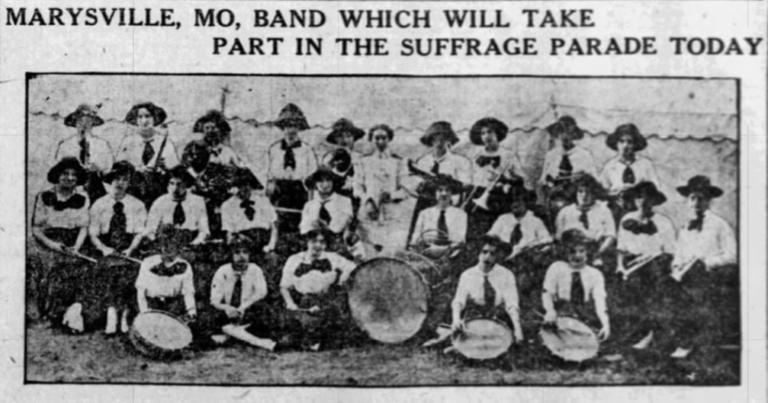ALMA NASH
- Program
- Subject
- Location
- Lat/Long
- Grant Recipient
-
National Votes for Women Trail
-
Event, People
- 46 West 3rd, Maryville, MO 64468, USA
- 40.3478982, -94.8728974
-
National Collaborative for Women's History Sites
ALMA NASH
Inscription
ALMA NASHLED MARYVILLE WOMEN IN THE
MISSOURI LADIES MILITARY BAND
IN NATIONAL WOMEN'S SUFFRAGE
PARADE IN D.C. & SUFFRAGE TOUR
OF CENTRAL MISSOURI IN 1913.
WILLIAM G. POMEROY FOUNDATION 2022
On March 3, 1913 thousands marched on Pennsylvania Avenue in Washington, D.C. in support of women’s right to vote. Contemporary newspaper estimates put the crowd of spectators at a quarter of a million. Organized by national suffrage leader Alice Paul to be held the day before President Woodrow Wilson’s first inauguration, the parade was intended to put pressure on the new Wilson Administration, and attract national attention to the issue of a women’s suffrage amendment to the United States Constitution.
Missouri suffragist, musician, and bandleader, Alma Nash (1883-1965) led the Missouri Ladies Military Band, composed of women from Maryville, Nodaway County, Missouri, in the national women’s suffrage parade in Washington, D.C. The front page of the March 3, 1913 edition of the St. Louis Globe-Democrat ran the headline, “Maryville, Mo., Woman’s Band to Lead Pageant.” It reported how Missouri suffragists had planned for the Maryville band to lead the Missouri state float in the national suffrage parade, but parade organizers had instead “seen fit to place them at the head of the entire line” of the procession. The March 3, 1913 edition of the St. Joseph Gazette listed the names of the women in the Missouri Ladies Military Band, and provided a profile of the group:
“The band is directed by Miss Alma Nash, and has been organized about two years. Some of the best talent among Maryville young women is represented in it, and Maryville is justly proud of it. Many of its members are schoolteachers.”
Upon their arrival home from the Capitol, the March 8, 1913 issue of Maryville’s Daily Democrat-Forum included commentary from Nash in a front-page article. Nash described her band’s participation in the national suffrage demonstration:
“We were not right in the lead when the parade started, because a mounted escort of women with a number of officers of the National Equal Suffrage association walking behind, with our band following, was the order in which we first started. We had gone but a short distance, however, when the crowd began closing up toward the line of the parade, and men were blocking a place in the street a short distance ahead, when one of the suffragist officers came rushing back to us and told us to march on ahead and lead, and that it would be necessary for the band to open the way, which proved to be true. We were not molested in the least, and although the march was slow on account of the great crowds, no one offered to stand in our way down the avenue.”
After the national suffrage parade, Nash and the other Maryville women band members continued their suffrage advocacy, touring the state in support of women’s right to vote.
After decades of activism by suffragists like Nash and the Missouri Ladies Military Band, finally, on June 4, 1919, the United States Congress passed the Nineteenth Amendment which reads, “The right of citizens of the United States to vote shall not be denied or abridged by the United States or by any state on account of sex.” On July 3, Missouri ratified the Nineteenth Amendment and by August 1920, the necessary 36 states had ratified the amendment, securing women’s right to vote across the United States.



